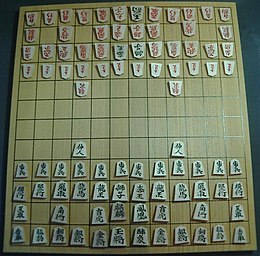 Chu shogi wood set. One side's pieces are all promoted (except for the unpromotable pieces), and show as red. | |
| Years active | Early 14th century to present |
|---|---|
| Genres | Board game Abstract strategy game |
| Players | 2 |
| Setup time | 2+ minutes |
| Playing time | 6–8 hours or more |
| Chance | None |
| Skills | strategy, tactics |
| Synonyms | Middle shogi |
Chu shogi (中将棋 chū shōgi or Middle Shogi) is a strategy board game native to Japan. It is similar to modern shogi (sometimes called Japanese chess) in its rules and gameplay. Its name means "mid-sized shogi", from a time when there were three sizes of shogi variants that were regularly being played. Chu shogi seems to have been developed in the early 14th century as a derivative of dai shogi ('large shogi'). There are earlier references, but it is not clear that they refer to the game as we now know it.
With fewer pieces than dai shogi, the game is considered more exciting, and was still commonly played in Japan in 1928–1939, especially in the Keihanshin region. The game largely died out after World War II despite the advocacy of prominent shogi players such as Okazaki Shimei and Ōyama Yasuharu[1] (who played chu shogi when young and credited it with the development of his personal cautious and tenacious shogi style). In 1976, there were about 30–40 masters of the game.[2] It has gained some adherents in the West, having been praised as "the best of all large chess games" by David Pritchard,[3] and still maintains a society (the Chushogi Renmei, or Japanese Chu Shogi Association) and an online following in Japan.
The main reference work in English is the Middle Shogi Manual by George Hodges.
- ^ "故・大山康晴名人による中将棋のススメ". 中将棋連盟. Retrieved 29 September 2014.
- ^ Hodges, GF (1976). "Middle shogi & how to play it". Shogi (1): 10–12.
- ^ Pritchard, D. B. (2007). "§28 Japan". In Beasley, John (ed.). The Classified Encyclopedia of Chess Variants. John Beasley. pp. 252–261. ISBN 978-0-9555168-0-1.